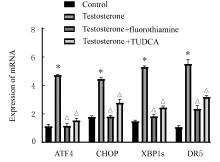| 1 |
TAY C T, JOHAM A E, HIAM D S, et al. Pharmacological and surgical treatment of nonreproductive outcomes in polycystic ovary syndrome: an overview of systematic reviews[J]. Clin Endocrinol, 2018, 89(5): 535-553.
|
| 2 |
MIKAEILI S, RASHIDI B H, SAFA M, et al. Altered FoxO3 expression and apoptosis in granulosa cells of women with polycystic ovary syndrome[J]. Arch Gynecol Obstet, 2016, 294(1): 185-192.
|
| 3 |
MA M N, WANG H M, ZHANG Y, et al. circRNA-mediated inhibin-activin balance regulation in ovarian granulosa cell apoptosis and follicular atresia[J]. Int J Mol Sci, 2021, 22(17): 9113.
|
| 4 |
HARADA M, TAKAHASHI N, AZHARY J M,et al. Endoplasmic reticulum stress: a key regulator of the follicular microenvironment in the ovary[J]. Mol Hum Reprod, 2021, 27(1): gaaa088.
|
| 5 |
LIU J, LUO L F, WANG D L, et al. Cadmium induces ovarian granulosa cell damage by activating PERK-eIF2α-ATF4 through endoplasmic reticulum stress[J]. Biol Reprod, 2019, 100(1): 292-299.
|
| 6 |
VAŠÍČKOVÁ K, MORÁŇ L, GURÍN D, et al. Alleviation of endoplasmic reticulum stress by tauroursodeoxycholic acid delays senescence of mouse ovarian surface epithelium[J]. Cell Tissue Res, 2018, 374(3): 643-652.
|
| 7 |
PARK H J, PARK J Y, KIM J W, et al. Melatonin improves the meiotic maturation of porcine oocytes by reducing endoplasmic reticulum stress during in vitro maturation[J]. J Pineal Res, 2018, 64(2): e12458.
|
| 8 |
李 娜, 尤娟娟, 权丽丽. miR-1285对卵巢癌OVCAR3细胞侵袭迁移的影响及其机制[J].解放军医学杂志,2021,46(1):26-31.
|
| 9 |
HARADA M, NOSE E, TAKAHASHI N, et al. Evidence of the activation of unfolded protein response in granulosa and cumulus cells during follicular growth and maturation[J]. Gynecol Endocrinol, 2015, 31(10): 783-787.
|
| 10 |
TAKAHASHI N, HARADA M, HIROTA Y, et al. Activation of endoplasmic reticulum stress in granulosa cells from patients with polycystic ovary syndrome contributes to ovarian fibrosis[J]. Sci Rep, 2017, 7(1): 10824.
|
| 11 |
BRENJIAN S, MOINI A, YAMINI N, et al. Resveratrol treatment in patients with polycystic ovary syndrome decreased pro-inflammatory and endoplasmic reticulum stress markers[J]. Am J Reprod Immunol, 2020, 83(1): e13186.
|
| 12 |
SHENG X, ARNOLDUSSEN Y J, STORM M, et al. Divergent androgen regulation of unfolded protein response pathways drives prostate cancer[J]. EMBO Mol Med, 2015, 7(6): 788-801.
|
| 13 |
CUI Y, MA Z, ZHAO H, et al. Activation of eIF2α signaling cascade is associated with testosterone-induced cell apoptosis in INS-1 cells[J]. Horm Metab Res, 2014, 46(8): 574-580.
|
| 14 |
YANG Y C, FU H C, HSIAO B L, et al. Androgen receptor inclusions acquire GRP78/BiP to ameliorate androgen-induced protein misfolding stress in embryonic stem cells[J]. Cell Death Dis, 2013, 4(4): e607.
|
| 15 |
LIM S S, KAKOLY N S, TAN J W J, et al. Metabolic syndrome in polycystic ovary syndrome: a systematic review, meta-analysis and meta-regression[J]. Obes Rev, 2019, 20(2): 339-352.
|
| 16 |
YANG D Q, JIANG T T, LIN P F, et al. Knock-down of apoptosis inducing factor gene protects endoplasmic reticulum stress-mediated goat granulosa cell apoptosis[J]. Theriogenology, 2017, 88: 89-97.
|
| 17 |
WANG M, KAUFMAN R J. Protein misfolding in the endoplasmic reticulum as a conduit to human disease[J]. Nature, 2016, 529(7586): 326-335.
|
| 18 |
TSAI Y L, HA D P, ZHAO H, et al. Endoplasmic reticulum stress activates SRC, relocating chaperones to the cell surface where GRP78/CD109 blocks TGF-β signaling[J]. Proc Natl Acad Sci USA, 2018, 115(18): E4245-E4254.
|
| 19 |
HUANG N, YU Y, QIAO J. Dual role for the unfolded protein response in the ovary: adaption and apoptosis[J]. Protein Cell, 2017, 8(1): 14-24.
|
| 20 |
HWANG J, QI L. Quality control in the endoplasmic reticulum: crosstalk between ERAD and UPR pathways[J].Trends Biochem Sci,2018,43(8):593-605.
|
| 21 |
WU L L, RUSSELL D L, NORMAN R J, et al. Endoplasmic reticulum (ER) stress in cumulus-oocyte complexes impairs pentraxin-3 secretion, mitochondrial membrane potential,and embryo development[J]. Mol Endocrinol,2012,26(4): 562-573.
|
| 22 |
JIN J M, MA Y R, TONG X M, et al. Metformin inhibits testosterone-induced endoplasmic reticulum stress in ovarian granulosa cells via inactivation of p38 MAPK[J]. Hum Reprod, 2020, 35(5): 1145-1158.
|
| 23 |
OZCAN L, TABAS I. Role of endoplasmic reticulum stress in metabolic disease and other disorders[J]. Annu Rev Med, 2012, 63: 317-328.
|
| 24 |
CHEN X, SHEN W B, YANG P H, et al. High glucose inhibits neural stem cell differentiation through oxidative stress and endoplasmic reticulum stress[J]. Stem Cells Dev, 2018, 27(11): 745-755.
|
| 25 |
GONZÁLEZ F. Inflammation in Polycystic Ovary Syndrome: underpinning of insulin resistance and ovarian dysfunction[J]. Steroids, 2012, 77(4): 300-305.
|
| 26 |
AZHARY J M K, HARADA M, TAKAHASHI N, et al. Endoplasmic reticulum stress activated by androgen enhances apoptosis of granulosa cells via induction of death receptor 5 in PCOS[J].Endocrinology, 2019, 160(1): 119-132.
|
 )
)




